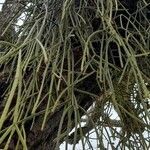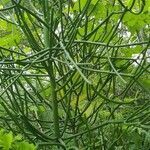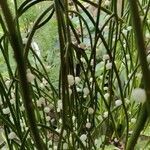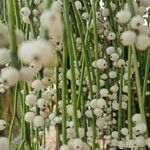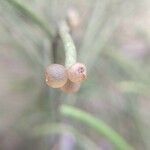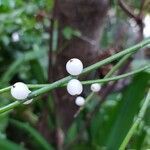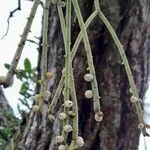Much-branched pendent epiphytic shrub l–3(–9) m. long.. Stems slender, cylindric, 2–8 mm. in diameter, sometimes slightly furrowed, arising in pairs or clusters from tips of older branches, pale green, occasionally producing adventitious roots.. Areoles subtended by minute triangular scales, naked or with l(–2) short stiff bristles 1 mm. long.. Flowers lateral, solitary, small, white or yellowish.. Perianth-segments 9–12, outermost triangular, inner oblong, obtuse, 2–3 mm. long.. Stamens ± 10–20, inserted at base of perianth, ± as long as perianth.. Style thick; stigmas 3–5.. Berry spherical or somewhat elongate, 5–8 mm. in diameter, pellucid, white, pink or red.. Seeds black, glossy, subpyriform, ± 1 mm. long.. Fig. 2, p. 6.
A cactus. It has many branches and grows attached to other plants and hangs down. It is 1-3 m long. The stems are slender and succulent. They are pale green. It does not have leaves but can have small scale leaves. The flowers are small and white or pale yellow. The fruit are small berries. They can be white, pink or red. They have several small black seeds. The fruit are produced in great numbers. They are edible.
Much-branched succulent unarmed epiphytic shrub up to 3 m. long, pendent; stems ± furrowed, green or pale green, with ± verticillate articulated branches up to 1 m. long, sometimes producing adventitious roots at branch apices; branches cylindrical, green, leafless; young plants with areoles subtended by minute triangular scales with 1(2) deciduous tufted setae.
Ovary prominent, c. 3 × 2·5 mm., with numerous ovules; style thick, ± as long as segments of perianth; stigma 3–5-partite with oblong fleshy spreading lobes.
Perianth-segments unequal, the outermost ± triangular to oblong, unequal, the inner ones up to 3 mm. long, oblong to ovate-oblong, spreading, translucent.
Fruit 4–8 mm. in diameter, a spherical or elongate white or pink berry, pellucid, surmounted by the remains of perianth, with a viscid pulp.
Stamens c. 20, slightly shorter than inner segments of perianth; anthers ± 0·5 mm. in diameter, globular.
Flowers up to 10 mm. in diameter, white or greenish-white, often numerous along the branches.
Seeds c. 1 mm. long, black, glossy, finely pitted, subpyriform.
